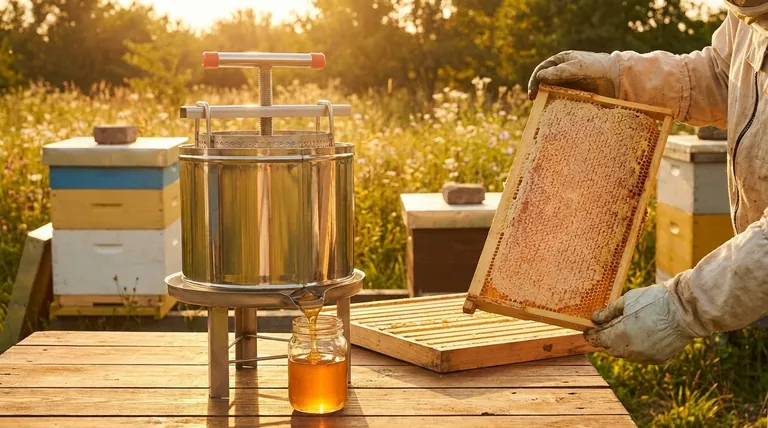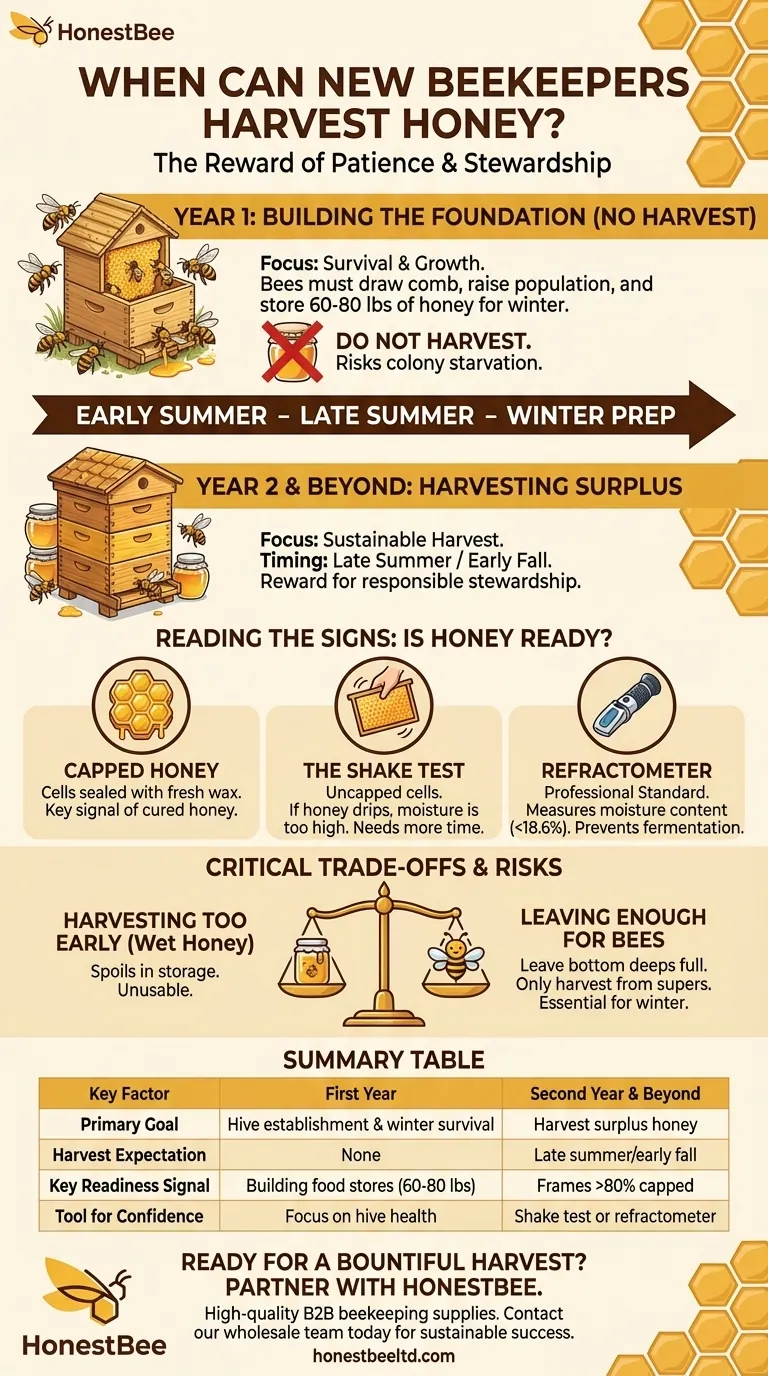For new beekeepers, the most anticipated reward of honey is an exercise in patience. You should not expect a honey harvest in your first year. The colony's entire focus is on building its home and storing enough resources—at least 60-80 pounds of honey—to survive the critical first winter.
The core principle is simple: the bees' needs come first. A first-year harvest risks the colony's survival, while a second-year harvest, timed correctly, is the reward for responsible stewardship. Success isn't about a date on the calendar, but about understanding the signals of a thriving, productive hive.

Why Your First Year is for the Bees, Not for You
A new bee colony, whether from a package or a nuc, is starting from scratch. Their labor in the first season is dedicated entirely to building a sustainable home.
The Colony's Top Priority: Survival
The bees' primary objective is to draw out wax comb, raise a large population of worker bees, and gather enough nectar and pollen to create the food stores needed to endure their first winter.
Building a Foundation
Foragers are tasked with collecting nectar, which they convert into honey. Simultaneously, the queen is laying eggs to build the workforce. This entire process consumes an enormous amount of energy and resources.
The High Cost of a First-Year Harvest
Taking honey during this foundational year diverts critical food stores. This can easily lead to the colony starving over the winter, undoing all your work and investment. The health of the hive must be the sole priority.
Reading the Signs: When is Honey Ready?
After your colony has successfully survived its first winter, you can begin looking for signs of surplus honey in your second season, typically in late summer or early fall.
The Key Signal: Capped Honey
When bees have filled a cell with honey and reduced its moisture content to the correct level (below 18.6%), they seal it with a fresh wax cap. This "capping" is the bees' own signal that the honey is cured and ready for long-term storage.
The "Shake Test" for Uncapped Cells
Some cells on a frame may remain uncapped. To check if the honey inside is ready, hold the frame horizontally over the hive and give it a firm shake. If honey or nectar drips out, the moisture content is too high, and the frame needs more time.
The Professional Standard: A Refractometer
For a definitive measurement, beekeepers use a tool called a honey refractometer. This device precisely measures the percentage of water in a honey sample, removing all guesswork. This ensures the honey will not ferment after being bottled.
Understanding the Critical Trade-offs
Harvesting is a balancing act. Timing is everything, and mistakes can compromise your entire harvest or the health of your hive.
The Risk of Harvesting Too Early
Harvesting "wet" or uncured honey (with a moisture content above ~18.6%) is a common beginner mistake. This honey will ferment and spoil in storage, making it unusable. The bees know when it's ready; patience is your best tool.
The Importance of Leaving Enough for the Bees
Even in an established hive, you must never take all the honey. Always leave the bottom deep hive bodies full of honey for the bees themselves. You should only harvest from the extra boxes, known as honey supers, placed on top.
Making the Right Choice for Your Goal
Your approach should be guided by the age of your hive and your commitment to its long-term health.
- If you are in your first year: Focus entirely on supporting hive health and preparing it for winter. Do not plan for any honey harvest.
- If you are in your second year or beyond: Begin monitoring your honey supers in late summer. Harvest only from frames that are at least 80% capped with wax.
- If your priority is ensuring the highest quality: Use the shake test as a quick field guide, but invest in a honey refractometer to guarantee your honey has the correct moisture content before you bottle it.
Patience in your first year is the foundation for many successful and sustainable harvests in the years to come.
Summary Table:
| Key Factor | First Year | Second Year & Beyond |
|---|---|---|
| Primary Goal | Hive establishment & winter survival | Harvest surplus honey |
| Harvest Expectation | None | Late summer/early fall |
| Key Readiness Signal | Building food stores (60-80 lbs) | Frames are >80% capped with wax |
| Tool for Confidence | Focus on hive health | Use a shake test or refractometer |
Ready for a Bountiful Harvest? Partner with HONESTBEE.
Setting up your apiary for long-term success starts with the right equipment. HONESTBEE supplies durable, high-quality beekeeping supplies and equipment to commercial apiaries and distributors through our wholesale-focused operations. From essential hive components to honey extraction tools, we provide the reliable foundation your beekeeping business needs to thrive season after season.
Contact our wholesale team today to discuss your apiary's needs and build a partnership for sustainable success.
Visual Guide

Related Products
- Stainless Steel Manual Honey Press with Guard for Pressing Honey and Wax
- Heavy Duty Stainless Steel Honeycomb Cutter
- Extra Wide Stainless Steel Honey Uncapping Fork with Scraper Beekeeping Tool
- Professional Long-Handled Silicone Honey Scraper for Beekeeping
- Professional Wide Blade Honey Scraper for Beekeeping and Honey Processing
People Also Ask
- What are the key features of a honey press? Maximize Yield with Durable, Efficient Extraction
- What are the uses of honey in various industries? Unlock Its Functional Power in Food, Pharma & Cosmetics
- What are the suggestions for using the honey press? A Guide to Efficient, Small-Scale Honey Extraction
- What are the multipurpose functionalities of a honey press? Versatile Harvesting for Beekeepers & Homesteaders
- What happens to the wax after pressing in a honey press? A Guide to Maximizing Your Hive's Yield



















